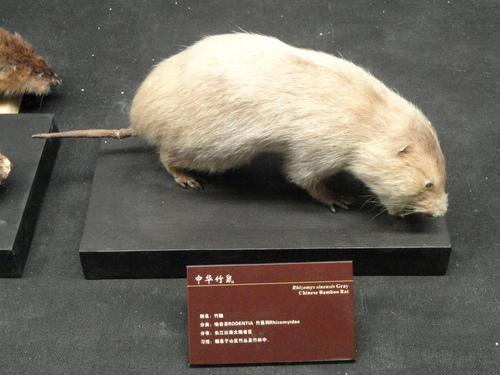
Chinese Bamboo Rat
The Chinese bamboo rat, Rhizomys sinensis, thrives in Southeast Asian forests. With powerful digging claws and a penchant for bamboo roots, these burrowing rodents contribute to soil health. Their dense fur and robust build make them well-adapted to subterranean life, highlighting their unique ecological niche.
4-5 years
Lifespan
3.99284 kg
Weight
Length: 23 - 50 cm
Size
Brown, Grey
Color
3-4 months
Age of Sexual Maturity
Least Concern
Conservation Status
Unknown
Population Trend
Characteristics
Rhizomys sinensis, commonly known as the Chinese bamboo rat, is a burrowing rodent found in the forests and grasslands of Southeast Asia. This species is known for its robust body, dense fur, and strong digging claws. It primarily feeds on bamboo roots and plays a role in soil aeration through its burrowing activities.
Distribution Range of the Chinese Bamboo Rat
Rhizomys sinensis, commonly known as the Chinese bamboo rat, is native to parts of East Asia, primarily found in China. Its range extends across several provinces in central and southern China, including Sichuan, Yunnan, Guizhou, and Guangxi. It may also be found in parts of northern Vietnam.
Chinese Bamboo Rat's Habitat
Environmental Conditions
The Chinese bamboo rat inhabits subtropical and temperate forested areas, often at elevations ranging from 500 to 2,000 meters. These regions are characterized by a temperate climate with distinct seasonal variations, including a warm, humid summer and a cooler, drier winter. The animal is typically found in areas with dense undergrowth and abundant bamboo vegetation, which provides both food and shelter.
Ecological Niche
Rhizomys sinensis is primarily a burrowing rodent that prefers bamboo forests and other areas with soft, moist soil that is conducive to digging. It plays a role in its ecosystem by influencing soil composition and structure through its burrowing activities. The species is herbivorous, feeding mainly on bamboo roots and stems, which positions it as a significant consumer in the bamboo forest ecosystem. Its burrowing behavior also contributes to soil aeration and the cycling of nutrients.
Copyright @ Nature Style Limited. All Rights Reserved.
 English
English